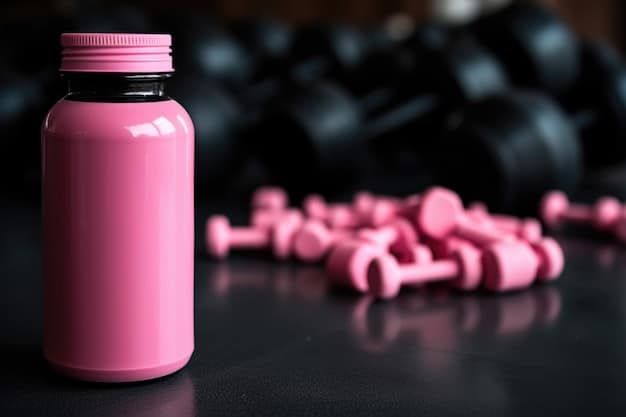Top 5 Joint Health Supplements for Lifters

Maintaining optimal joint health is crucial for lifters to sustain peak performance and longevity in their training, making the strategic incorporation of targeted supplements a vital component in reducing pain and enhancing mobility.
For any dedicated lifter, the pursuit of strength and muscle mass often comes with the understanding that joint health is paramount. Without proper care, the constant demands placed on joints during intense training can lead to discomfort, stiffness, and even significant injuries, hindering progress and passion. This comprehensive guide delves into The Top 5 Supplements for Joint Health: Reduce Pain and Improve Mobility for Lifters, providing insights into how these key compounds can support your joints, allowing you to train harder, recover faster, and extend your lifting career.
understanding joint stress in lifting
Lifting weights, while incredibly beneficial for building muscle and bone density, inherently places substantial stress on the body’s joints. Each repetition, particularly with heavy loads, compresses and stretches the cartilage, ligaments, and tendons that comprise these crucial anatomical structures. This repetitive mechanical load, coupled with the systemic inflammation that occurs after intense exercise, can progressively degrade joint tissues over time. For lifters, this often manifests as persistent aches, reduced range of motion, and a decreased capacity to perform exercises that were once routine.
The type of lifting also influences the nature and severity of joint stress. Powerlifters, focusing on maximal strength in compound movements like squats, bench presses, and deadlifts, subject their joints to immense pressure, particularly the knees, hips, and shoulders. Bodybuilders, who often emphasize high-volume training and isolation exercises, may experience more chronic, cumulative wear and tear, especially in smaller joints. Olympic weightlifters, with their explosive, precise movements, demand extraordinary flexibility and resilience from their wrist, elbow, shoulder, and ankle joints. Understanding these specific stressors is the first step toward effective joint support.
The Role of Cartilage and Synovial Fluid
Within every joint, articular cartilage acts as a smooth, elastic cushion, allowing bones to glide effortlessly past each other. This cartilage has no direct blood supply; instead, it relies on synovial fluid for nourishment and lubrication. Synovial fluid, a viscous material, also minimizes friction and absorbs shock. In lifters, repetitive impacts and shear forces can compromise the integrity of cartilage, leading to micro-tears and gradual erosion. As cartilage thins, bone-on-bone friction can occur, leading to pain and inflammation. The quality and quantity of synovial fluid can also be affected by inflammation and dehydration, further impairing joint function.
- Cartilage integrity is vital for smooth joint movement and shock absorption.
- Synovial fluid lubricates joints and provides essential nutrients to cartilage.
- High-impact lifting can accelerate cartilage wear and reduce synovial fluid efficacy.
- Inflammation from strenuous exercise can exacerbate joint degradation.
The constant cycle of breakdown and repair in joint tissues demands a robust and consistent supply of the necessary building blocks. Without adequate support, the rate of degradation can outpace the body’s natural repair mechanisms, leading to chronic joint issues. This underscores the importance of proactive measures, including targeted supplementation, to mitigate the adverse effects of strenuous training and foster an environment conducive to joint health and recovery.
Managing this stress proactively is not just about avoiding injury; it’s about optimizing performance. A joint that is free from pain and has a full range of motion can generate more force, move through a greater arc, and recover more quickly. This translates directly into better lifts, more effective training sessions, and ultimately, greater progress in the gym. Ignoring early signs of joint discomfort can lead to a cascade of problems, forcing layoffs and potentially long-term limitations. Therefore, incorporating strategies to support joint health is an integral part of any serious lifter’s regimen, just as important as perfecting technique or managing progressive overload.

Glucosamine and Chondroitin: The foundational duo
Among the most widely recognized and extensively researched supplements for joint health are glucosamine and chondroitin. Often found together in formulations, these two compounds are natural components of healthy cartilage and synovial fluid. They play a critical role in maintaining the structural integrity of joints and supporting their proper function, making them a cornerstone for lifters looking to preserve and improve their joint mobility.
Glucosamine: A Building Block for Cartilage
Glucosamine, an amino sugar, serves as a primary building block for glycosaminoglycans and proteoglycans, which are major components of cartilage. It is involved in the synthesis of new cartilage and helps to maintain the existing cartilage matrix. There are several forms of glucosamine available, with **glucosamine sulfate** being the most studied and generally recommended for joint health due to its superior absorption and bioavailability. Its role in cartilage repair and regeneration makes it particularly appealing for lifters who constantly subject their joints to high-impact stress.
- Glucosamine is essential for the construction and maintenance of cartilage.
- It aids in synthesizing crucial proteoglycans and glycosaminoglycans.
- Glucosamine sulfate is the most effective form due to better absorption.
- Consistent intake may support cartilage integrity under mechanical stress.
Research on glucosamine’s efficacy has yielded mixed results, largely due to variations in study design, dosage, and the type of glucosamine used. However, a significant body of evidence suggests that for individuals with mild to moderate joint discomfort, particularly those stemming from strenuous physical activity, glucosamine can offer symptomatic relief and potentially slow the progression of cartilage degeneration. For lifters, this could translate to reduced post-workout soreness and better long-term joint resilience.
Chondroitin: Cartilage Elasticity and Fluid Retention
Chondroitin sulfate is another key component of human connective tissues, particularly cartilage. Its primary function within the joint is to help cartilage retain water, which is crucial for its elasticity, shock-absorbing properties, and overall resilience. Chondroitin also inhibits enzymes that break down cartilage and promotes the synthesis of new cartilage components. By ensuring proper hydration and protection of the cartilage, chondroitin helps maintain the smooth, friction-free movement within the joint, which is vital for movements like squatting, pressing, and pulling.
When glucosamine and chondroitin are used together, the idea is that their synergistic effects might amplify their individual benefits. Glucosamine provides the raw materials for cartilage, while chondroitin helps maintain its structure and prevents its breakdown. This combined approach is often preferred by many lifters and healthcare professionals. While not a magic bullet for reversing severe joint damage, consistent supplementation with this duo can contribute significantly to preventive joint care and management of mild discomfort stemming from the rigors of heavy lifting, prolonging an athlete’s ability to train effectively and comfortably.
It’s important to note that the effects of glucosamine and chondroitin are typically not immediate. Consistent use over several weeks or months is usually required before noticeable benefits are experienced. This long-term commitment reflects their role in structural support rather than acute pain relief. For lifters, integrating these supplements into their daily routine for sustained periods can offer a proactive strategy for preserving joint health against the relentless wear and tear of a demanding training regimen.
MSM: Supporting Tissue Integrity and Reducing Inflammation
Methylsulfonylmethane, commonly known as MSM, is an organic sulfur-containing compound widely used for its anti-inflammatory and pain-reducing properties, particularly in the context of joint health. Sulfur is a fundamental element found in all living organisms and is crucial for the formation of connective tissues, including cartilage, tendons, and ligaments. For lifters, whose connective tissues undergo constant stress and repair cycles, maintaining adequate sulfur levels is vital. MSM provides a bioavailable form of sulfur, which is readily utilized by the body to synthesize these essential components.
One of the primary mechanisms through which MSM benefits joint health is its role in reducing inflammation. Strenuous exercise, especially heavy lifting, invariably leads to micro-trauma and subsequent inflammatory responses in the body. While acute inflammation is part of the healing process, chronic or excessive inflammation can contribute to joint pain and accelerate tissue degradation. MSM helps to modulate inflammatory pathways, potentially by inhibiting NF-κB, a protein complex that controls transcription of DNA and is responsible for regulating immune response to infection and inflammation.
- MSM is a bioavailable source of sulfur, essential for connective tissue formation.
- It possesses significant anti-inflammatory properties, mitigating exercise-induced inflammation.
- MSM can help reduce post-exercise muscle and joint soreness, aiding recovery.
- Its antioxidant activity contributes to protecting joint cells from oxidative damage.
Beyond its anti-inflammatory effects, MSM is also thought to act as an antioxidant. Intense physical activity increases the production of free radicals, which can cause oxidative damage to cells and tissues, including those in the joints. By scavenging these free radicals, MSM may help protect joint structures from cellular damage, thus supporting their long-term health and function. For lifters, this protection is crucial in maintaining joint integrity against the constant biochemical stress of training.
Anecdotal evidence and some studies suggest that MSM can significantly reduce joint pain and improve physical function, particularly in individuals experiencing discomfort related to exercise or conditions like osteoarthritis. It is often combined with other joint-supportive supplements, such as glucosamine and chondroitin, to create a more comprehensive approach to joint care. The synergy between these compounds is believed to enhance their individual benefits, leading to a more profound impact on overall joint health and mobility.
The pain-reducing effects of MSM are particularly beneficial for lifters, as it can help manage the discomfort that often accompanies heavy training. This allows athletes to maintain consistency in their training regimen, which is a key factor in achieving long-term progress. By providing relief from soreness and supporting faster recovery, MSM enables lifters to return to their workouts feeling more prepared and less inhibited by joint aches. Its ability to support tissue integrity and reduce inflammation makes it an invaluable addition to a lifter’s supplement stack, contributing to both immediate comfort and the long-term resilience of their joints.
Collagen: Rebuilding Connective Tissues
Collagen is the most abundant protein in the human body, forming the primary structural component of connective tissues, including tendons, ligaments, cartilage, bones, and skin. For lifters, who subject these tissues to immense mechanical stress, maintaining adequate collagen synthesis is not just beneficial—it’s essential for joint health, injury prevention, and rapid recovery. Unlike other proteins, collagen provides tensile strength and elasticity, allowing tissues to withstand forces and return to their original shape.
There are several types of collagen, but for joint health, **Type I** (found in tendons, ligaments, bones) and **Type II** (the primary collagen in cartilage) are most relevant. Collagen supplements, typically derived from bovine or marine sources, come in various forms, with **hydrolyzed collagen** (also known as collagen peptides) being the most common. Hydrolyzed collagen has a lower molecular weight, meaning it’s more easily absorbed by the body, where it can then be used to synthesize new collagen fibers or stimulate the body’s own collagen production.
- Collagen is the foundational protein for all connective tissues, including joints.
- Hydrolyzed collagen (peptides) is highly bioavailable and easily absorbed.
- It supports the strength and elasticity of tendons, ligaments, and cartilage.
- Supplementation can aid in injury recovery and reduce joint pain due to tissue wear.
One of the key benefits of collagen supplementation for lifters is its potential to support the repair and regeneration of damaged joint tissues. Studies suggest that collagen peptides can accumulate in cartilage and stimulate chondrocytes (cartilage cells) to produce new collagen and other matrix components. This can contribute to enhanced joint comfort, reduced stiffness, and improved function, which are all crucial for maintaining performance in the gym. By providing the crucial building blocks, collagen helps the body keep pace with the demands of intense training.
Furthermore, collagen’s role in strengthening tendons and ligaments is particularly valuable for injury prevention. These tissues connect muscles to bones and bones to bones, respectively, and are often vulnerable to strains and tears under heavy loads. Enhanced collagen synthesis can improve the resilience of these structures, making them more durable and less prone to injury. This proactive approach to tissue health can significantly extend a lifter’s career and reduce the downtime associated with tendonitis or ligament sprains.
Many lifters report a noticeable reduction in joint pain and a feeling of greater “cushioning” in their joints after consistent collagen supplementation. It’s not uncommon to see collagen peptides used alongside protein powders or morning beverages due to their ease of mixing and lack of taste. Incorporating collagen into a daily routine provides the body with a steady supply of this vital protein, fostering an environment where connective tissues can continuously rebuild and strengthen, thereby optimizing joint resilience and ensuring long-term lifting success.
Omega-3 Fatty Acids: Powerful Anti-Inflammatory Support
Omega-3 fatty acids, particularly EPA (eicosapentaenoic acid) and DHA (docosahexaenoic acid), are renowned for their potent anti-inflammatory properties. While not directly involved in building joint structures like collagen or glucosamine, their role in modulating the body’s inflammatory response is critically important for joint health, especially for lifters who constantly contend with exercise-induced inflammation. Chronic low-grade inflammation can contribute to joint pain, stiffness, and long-term degradation of cartilage, making omega-3s an indispensable supplement for proactive joint care.
When tissues are stressed, such as during heavy lifting, the body produces inflammatory compounds called eicosanoids. Omega-3 fatty acids compete with omega-6 fatty acids (which typically promote inflammation) for the same enzymes. By shifting the balance towards omega-3 derived eicosanoids, these fatty acids help produce less inflammatory compounds, effectively dampening the overall inflammatory response. This can lead to a reduction in joint swelling, pain, and stiffness, making recovery faster and more comfortable for lifters.
- Omega-3s (EPA & DHA) are powerful anti-inflammatory agents.
- They help reduce exercise-induced joint inflammation and pain.
- Contribute to improved blood flow, aiding nutrient delivery to joints.
- Support overall cellular health, including joint tissue viability.
Beyond systemic inflammation, omega-3s also contribute to the health of the cell membranes throughout the body, making them more pliable and functional. This includes the cells within joint tissues, which can benefit from enhanced nutrient exchange and waste removal. Improved cellular health translates to better resilience and repair capabilities for cartilage and other connective tissues. For lifters, this means healthier joints that are better equipped to handle the repeated stress of intense training sessions.
Supplementing with a high-quality fish oil or algal oil rich in EPA and DHA can make a noticeable difference in reducing post-workout joint soreness and accelerating recovery. Many lifters incorporate omega-3s not just for joint health, but also for their broader benefits on cardiovascular health, brain function, and overall well-being. This multifaceted support makes omega-3 fatty acids a highly valuable addition to any lifter’s supplement regimen, contributing not just to joint specific benefits but to overall systemic health that underpins peak physical performance.
Dosage is important with omega-3s; many experts recommend at least 1,000 mg of combined EPA and DHA daily for general health, with higher doses (2,000-4,000 mg) potentially beneficial for managing inflammation and joint pain in active individuals. Consistent intake is key, as the benefits accumulate over time by slowly shifting the body’s inflammatory balance. For lifters concerned about the cumulative impact of training on their joints, prioritizing omega-3 supplementation offers a foundational layer of protection against the damaging effects of chronic inflammation.
Curcumin (Turmeric Extract): Nature’s Anti-Inflammatory Powerhouse
Curcumin, the primary active compound in the spice turmeric, has gained significant attention for its potent anti-inflammatory and antioxidant properties. While turmeric has been used for centuries in traditional medicine, modern science has elucidated curcumin’s mechanisms of action, making it a compelling supplement for lifters seeking to mitigate joint pain and reduce inflammation. Its ability to combat inflammation through multiple pathways sets it apart as a natural alternative or complementary agent to conventional pain relief strategies.
One of the key ways curcumin works is by inhibiting various molecular targets involved in the inflammatory cascade, including NF-κB, COX-2, and LOX enzymes. By modulating these pathways, curcumin effectively reduces the production of pro-inflammatory molecules (cytokines, prostaglandins, leukotrienes) that contribute to joint pain, swelling, and stiffness. For lifters, who frequently experience exercise-induced inflammation, this can lead to faster recovery and reduced discomfort after demanding workouts, enabling more consistent and effective training.
Enhanced Bioavailability for Maximum Impact
A significant challenge with curcumin is its poor bioavailability—it’s not well absorbed into the bloodstream. However, several forms of curcumin supplements have been developed to overcome this, often by combining curcumin with piperine (a compound in black pepper) or formulating it into liposomal or phospholipid complexes. These enhanced bioavailability formulations are crucial to ensure that enough curcumin reaches the joint tissues to exert its therapeutic effects. When choosing a curcumin supplement, prioritizing enhanced absorption is paramount for lifters.
- Curcumin is a potent anti-inflammatory from turmeric.
- It effectively reduces pro-inflammatory molecules, easing joint pain.
- Enhanced bioavailability formulations (with piperine or liposomes) are essential.
- Acts as a powerful antioxidant, protecting joint cells from oxidative stress.
In addition to its anti-inflammatory actions, curcumin also possesses powerful antioxidant properties. Regular intense exercise can increase oxidative stress in the body, which can damage joint cells and contribute to cartilage breakdown. Curcumin helps neutralize free radicals, protecting joint tissues from this oxidative damage and supporting their long-term health. This dual action targeting both inflammation and oxidative stress makes curcumin a comprehensive supplement for joint support in highly active individuals.
Numerous studies have demonstrated curcumin’s ability to alleviate joint pain and improve physical function in various conditions, similar to or even surpassing the effects of some NSAIDs, but with a more favorable side effect profile. For lifters, this means a natural way to manage the aches and pains that come with heavy training, without the potential gastrointestinal or cardiovascular side effects associated with prolonged NSAID use. Incorporating a well-absorbed curcumin supplement can be a game-changer for those looking to maintain peak joint performance and minimize recovery time from training-induced inflammation.
It’s important to approach curcumin supplementation with a long-term perspective. While some individuals may experience acute relief, the most significant benefits tend to accumulate with consistent daily use over several weeks or months. For serious lifters, adding curcumin to their supplement stack is a proactive step towards mitigating the inflammatory burden of training and safeguarding joint health, ensuring they can continue to push their limits with greater comfort and resilience.
integrating supplements into your routine
Successfully integrating joint health supplements into a lifter’s routine extends beyond simply taking pills; it involves a strategic approach to timing, dosage, and a holistic understanding of how these compounds support your body. Optimizing the absorption and efficacy of these supplements is pivotal to reaping their full benefits and ensuring they contribute meaningfully to your performance and longevity in the gym. This section provides practical guidance on how to best utilize these powerful compounds to maximize their impact on your joint health.
Developing a consistent routine is foundational. Most joint supplements, including glucosamine, chondroitin, MSM, collagen, omega-3s, and curcumin, work cumulatively over time rather than offering immediate, acute relief. Therefore, daily, consistent intake is far more beneficial than sporadic use. Setting a specific time each day to take your supplements, such as with a meal, can help establish a routine that is easy to adhere to. Incorporating them into existing habits, like breakfast or post-workout nutrition, can also improve compliance and ensure you don’t miss doses.
Dosage and Timing for Optimal Efficacy
Each supplement has recommended dosages that have been clinically studied. For **glucosamine sulfate**, common dosages range from 1,500 mg daily, often split into two or three doses. **Chondroitin** is typically taken at 800-1,200 mg per day. **MSM** dosages can vary widely from 1,000 mg to 6,000 mg daily, depending on individual need and tolerance. For all three, taking them with food can aid absorption and reduce potential stomach upset.
- Research evidence-based dosages for each supplement.
- Consider taking supplements with meals to enhance absorption.
- Be patient; benefits typically manifest after several weeks of consistent use.
- Listen to your body and adjust dosages or consult a professional if needed.
For **collagen peptides**, a typical dose is 10-20 grams daily, which can be easily mixed into smoothies, coffee, or water. The timing isn’t critical, but some lifters prefer it post-workout for recovery support. **Omega-3 fatty acids** (EPA and DHA) should aim for at least 1,000-2,000 mg of combined EPA+DHA daily, ideally with a fatty meal to maximize absorption. For **curcumin**, standard recommendations often range from 500-1000 mg of a high-bioavailability formulation daily, also best taken with food.
Synergistic Effects and Holistic Approach
Many of these supplements exert their effects through different pathways, making them complementary when taken together. For instance, while glucosamine and chondroitin focus on cartilage structure, MSM and curcumin tackle inflammation, and collagen provides foundational rebuilding blocks. Omega-3s offer systemic anti-inflammatory support. Combining them can offer a more comprehensive approach to joint health than relying on a single compound. However, always consult with a healthcare professional or a registered dietitian before starting any new supplement regimen, especially if you have pre-existing health conditions or are taking other medications.
Finally, remember that supplements are just one piece of the puzzle. They are meant to complement, not replace, other critical aspects of joint health, such as proper lifting technique, adequate warm-ups and cool-downs, sufficient rest and recovery, and a balanced, anti-inflammatory diet rich in whole foods, fruits, and vegetables. Hydration is also paramount, as water is a key component of synovial fluid and joint lubrication. By taking a holistic approach that integrates intelligent supplementation with optimized training practices and a healthy lifestyle, lifters can significantly enhance their joint resilience, reduce pain, improve mobility, and ultimately sustain their passion for lifting for years to come.
| Key Point | Brief Description |
|---|---|
| 🍖 Glucosamine & Chondroitin | Foundational blocks for cartilage repair and elasticity, crucial for joint structural integrity. |
| 🌱 MSM | Provides essential sulfur for connective tissues; effective in reducing inflammation and pain. |
| 💪 Collagen | Key protein for rebuilding tendons, ligaments, and cartilage, enhancing tissue strength and elasticity. |
| 🐟 Omega-3 & Curcumin | Powerful natural anti-inflammatories, crucial for managing exercise-induced joint soreness and protecting tissues. |
frequently asked questions about joint supplements
▼
Joint supplements typically require consistent use over several weeks to months before noticeable improvements are felt. This is because they work by supporting the body’s natural repair processes and accumulating in tissues, rather than providing immediate pain relief. Patience and adherence to the recommended dosage are key for optimal outcomes.
▼
Absolutely. While highly beneficial for lifters due to increased joint stress, these supplements are also effective for general joint health, active individuals, or those experiencing age-related joint discomfort. Their mechanisms of action are universal for supporting cartilage, reducing inflammation, and maintaining connective tissue integrity in anyone.
▼
Generally, these supplements are well-tolerated. However, mild side effects like digestive upset, nausea, or heartburn can occur, especially with glucosamine. Omega-3s can thin blood at very high doses, and curcumin may interact with certain medications. Always consult a healthcare professional before starting any new supplement, especially if you have underlying conditions.
▼
Efficacy can vary among individuals based on the severity of joint issues, genetics, and adherence to dosage. While many experience significant benefits, some may not perceive a difference. It’s often a process of trial and error, coupled with a holistic approach to joint care, including proper nutrition and training techniques.
▼
Yes, many joint supplement strategies involve combining several compounds for synergistic effects. For example, glucosamine and chondroitin often work well together. However, it’s crucial to check for overlapping ingredients in combination products to avoid excessive dosing and always consult with a doctor or qualified nutritionist for personalized advice.
conclusion
For individuals committed to the discipline of lifting, understanding and prioritizing joint health is not merely an optional addition to training; it is a fundamental pillar for sustained performance and long-term well-being. The constant demands placed on our joints necessitate a proactive approach that extends beyond proper form and adequate rest. Strategic supplementation with compounds like glucosamine, chondroitin, MSM, collagen, omega-3 fatty acids, and curcumin offers a robust line of defense against the wear and tear of intense training. By providing the body with the essential building blocks for cartilage and connective tissue repair, while simultaneously mitigating inflammation, these supplements empower lifters to reduce pain, enhance mobility, and ultimately, continue pushing their limits with greater resilience. Integrating these insights into your routine means investing in a healthier, more durable body, ensuring that your pursuit of strength remains a journey of progress, not pain.





